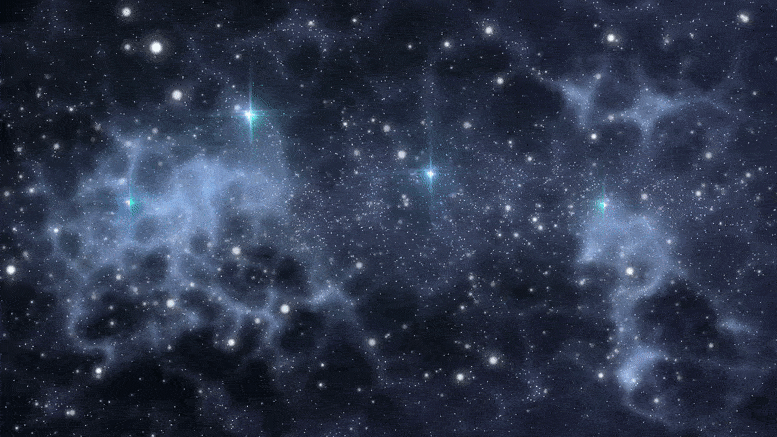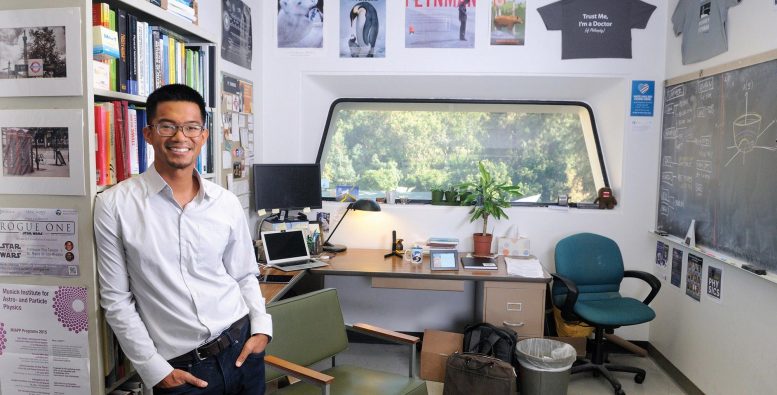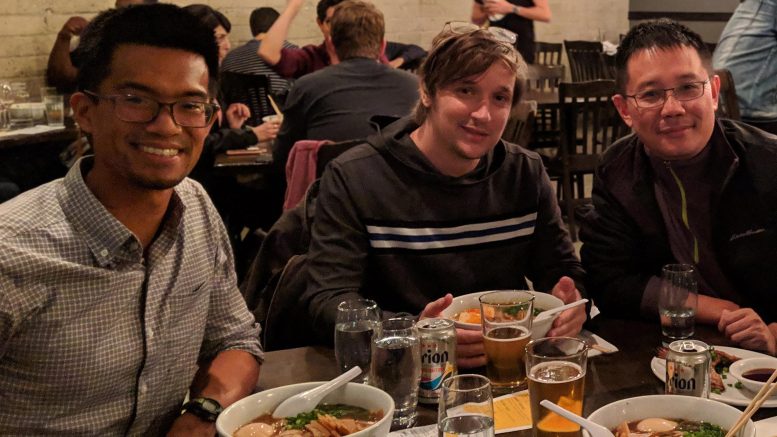As its name suggests, dark matter — material which makes up about 85% of the mass in the universe — emits no light, eluding easy detection. ...
 |
| As its name suggests, dark matter — material which makes up about 85% of the mass in the universe — emits no light, eluding easy detection. Its properties, too, remain fairly obscure. |
“We live in an ocean of dark matter, yet we know very little about what it could be,” said Flip Tanedo, an assistant professor of physics and astronomy and the paper’s senior author. “It is one of the most vexing known unknowns in nature. We know it exists, but we do not know how to look for it or why it hasn’t shown up where we expected it.”
Physicists have used telescopes, gigantic underground experiments, and colliders to learn more about dark matter for the last 30 years, though no positive evidence has materialized. The negative evidence, however, has forced theoretical physicists like Tanedo to think more creatively about what dark matter could be.
 |
| Flip Tanedo is an assistant professor of physics and astronomy at UC Riverside. Credit: Thomas Wasper |
The new research, which proposes the existence of an extra dimension in space-time to search for dark matter, is part of an ongoing research program at UC Riverside led by Tanedo. According to this theory, some of the dark matter particles don’t behave like particles. In effect, invisible particles interact with even more invisible particles in such a way that the latter cease to behave like particles.
“The goal of my research program for the past two years is to extend the idea of dark matter ‘talking’ to dark forces,” Tanedo said. “Over the past decade, physicists have come to appreciate that, in addition to dark matter, hidden dark forces may govern dark matter’s interactions. These could completely rewrite the rules for how one ought to look for dark matter.”
If two particles of dark matter are attracted to, or repelled by, each other, then dark forces are operating. Tanedo explained that dark forces are described mathematically by a theory with extra dimensions and appear as a continuum of particles that could address puzzles seen in small galaxies.
“Our ongoing research program at UCR is a further generalization of the dark force proposal,” he said. “Our observed universe has three dimensions of space. We propose that there may be a fourth dimension that only the dark forces know about. The extra dimension can explain why dark matter has hidden so well from our attempts to study it in a lab.”
 |
| Photo shows Flip Tanedo (left), Sylvain Fichet (center), and Hai-Bo Yu. Credit: Flip Tanedo, UC Riverside |
Tanedo explained that although extra dimensions may sound like an exotic idea, they are actually a mathematical trick to describe “conformal field theories” — ordinary three-dimensional theories that are highly quantum mechanical.
These types of theories are mathematically rich, but do not contain conventional particles and so are typically not considered to be relevant for describing nature. The mathematical equivalence between these challenging three-dimensional theories and a more tractable extra-dimensional theory is known as the holographic principle.
“Since these conformal field theories were both intractable and unusual, they hadn’t really been systematically applied to dark matter,” Tanedo added. “Instead of using that language, we work with the holographic extra-dimensional theory.”
The key feature of the extra-dimensional theory is that the force between dark matter particles is described by an infinite number of different particles with different masses called a continuum. In contrast, ordinary forces are described by a single type of particle with a fixed mass. This class of continuum-dark sectors is exciting to Tanedo because it does something “fresh and different.”
According to Tanedo, past work on dark sectors focuses primarily on theories that mimic the behavior of visible particles. His research program is exploring the more extreme types of theories that most particle physicists found less interesting, perhaps because no analogs exist in the real world.
In Tanedo’s theory, the force between dark matter particles is surprisingly different from the forces felt by ordinary matter.
“For the gravitational force or electric force that I teach in my introductory physics course, when you double the distance between two particles you reduce the force by a factor of four. A continuum force, on the other hand, is reduced by a factor of up to eight.”
What implications does this extra dimensional dark force have? Since ordinary matter may not interact with this dark force, Tanedo turned to the idea of self-interacting dark matter, an idea pioneered by Hai-Bo Yu, an associate professor of physics and astronomy at UCR who is not a coauthor on the paper. Yu showed that even in the absence of any interactions with normal matter, the effects of these dark forces could be observed indirectly in dwarf spheroidal galaxies. Tanedo’s team found the continuum force can reproduce the observed stellar motions.
“Our model goes further and makes it easier than the self-interacting dark matter model to explain the cosmic origin of dark matter,” Tanedo said.
Next, Tanedo’s team will explore a continuum version of the “dark photon” model.
“It’s a more realistic picture for a dark force,” Tanedo said. “Dark photons have been studied in great detail, but our extra-dimensional framework has a few surprises. We will also look into the cosmology of dark forces and the physics of black holes.”
Tanedo has been working diligently on identifying “blind spots” in his team’s search for dark matter.
“My research program targets one of the assumptions we make about particle physics: that the interaction of particles is well-described by the exchange of more particles,” he said. “While that is true for ordinary matter, there’s no reason to assume that for dark matter. Their interactions could be described by a continuum of exchanged particles rather than just exchanging a single type of force particle.”
Tanedo was joined in the research by Ian Chaffey, a postdoctoral researcher working with Tanedo; and Sylvain Fichet, a postdoctoral researcher at the International Center for Theoretical Physics – South American Institute for Fundamental Research in Brazil. The research was funded by the U.S. Department of Energy.
Reference: “Continuum-mediated self-interacting dark matter” by Ian Chaffey, Sylvain Fichet and Philip Tanedo, 1 June 2021, Journal of High Energy Physics.
DOI: 10.1007/JHEP06(2021)008

.webp)



